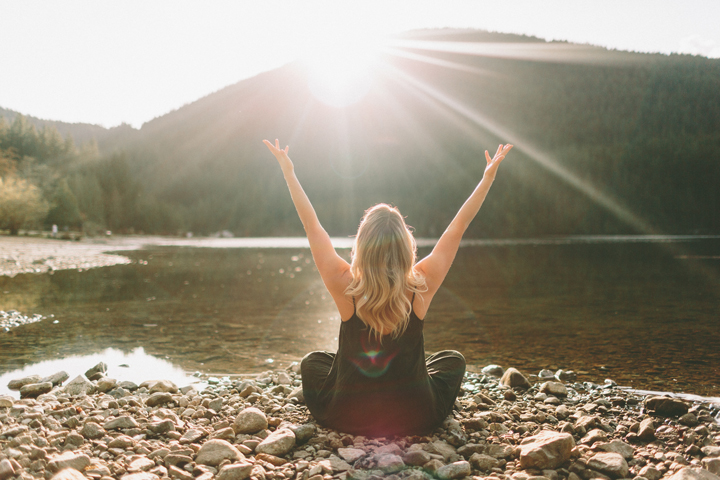It’s Thanksgiving week, which got me thinking about things I’m thankful for, which got me thinking about gratitude.
How many times have you heard that practicing gratitude is the secret to a happy life? If you’re like me, your social media pages are flooded this week with gratitude memes.
But why is it important, and more importantly, how do you actually make gratitude a practice?
When I wake up super early, like today, I don’t feel grateful; I feel annoyed. My brain starts in on my long list of things to do. I lament I didn’t get enough sleep; now I’m going into the day tired. The “what ifs” start, which is my particular brand of anxiety. What if I get a sleep deprivation headache? And then I can’t be really present to my family who is visiting? And then I get behind on all I need to do to pull off a Thanksgiving party for 16 people? And I get stressed out and short with my family? And my attitude ruins Thanksgiving? (“What ifs” are usually extreme).
I’ve been on this “what if” train so often, I recognize it quickly. And that’s when I start my habit of practicing gratitude.
Because gratitude throws a monkey wrench in the anxiety gears.
I start small — with what is right around me. I feel grateful for the feel of cotton percale sheets against my skin. “Thank you for clean sheets.” This makes me think of my pajamas and the fact that unlike much of the world, I have a special kind of clothes just for sleeping — even more than one of these kinds of clothes — so I can wear clean, special sleeping clothes to bed every night. “Thank you for pajamas.” This makes me think of my bed, so I say to myself, “thank you for my bed.” I momentarily think about needing to buy a new bed because this one isn’t the greatest for my back. I start to feel annoyed about aging, but catch myself and “thank you for my healthy body.”
It starts raining, but I’m safe and dry, so I say “thank you for the roof over my head.” I think of my house and how grateful I am, after renting for years in San Francisco, that we were able to buy our house here in Florida. “Thank you for my home.” I think of the rooms in my house; my children sleeping in their rooms. This makes me think of being a parent. There are a million and one ways to be irritated as a parent, but I catch myself as I start to get on that train and say “Thank you for my healthy, beautiful children.”
The path of gratitude meanders; I follow it.
Internally, symbolically, I bow with thanks for each small thing I notice that I can be grateful for.
I think of this as akin to the beautiful quote from the Talmud, “Every blade of grass has an Angel whispering to it, ‘Grow, grow.’” I dial into the minute, the small, the granular of life. Thank you.
But sometimes my gratitude practice has to view life from a great distance. Something so shitty is going on that the only way for me to handle it is to zoom out and force myself to look at the big picture. I pull away from my life to a birds eye view…or sometimes, a satellite view. And like Mr. Rogers says, to “Look for the helpers.”
I began practicing gratitude in my 20s, during one of these times. I was fortunate to come across a book called Simple Abundance by Sarah Ban Breathnach. The book was everywhere — bookstores, best seller lists, on Oprah. It has an essay and a quote for every day of the year. Early on in the book, Breathnach lays out several principles for the journey that the book invites the reader on, and one of them is a gratitude practice.
She writes, for the January 14th entry, “There are several tools that I’m going to suggest you use as you begin your inner exploration. While all of them will help you become happier and more content and will nurture your creativity, this first tool could change the quality of your life beyond belief: it’s what I call a daily gratitude journal. [E]ach night before I go to bed, I write down five things that I can be grateful for.”
For whatever reason, probably because I needed a life raft at this time in my life, I decided to follow this advice and for the next year, I wrote down things for which I was grateful for every day.
It was a massive struggle, to be honest, to do this on some days. I didn’t grow up with models for practicing gratitude. There was more than one day that year when I wrote down, 3 times, “I’m thankful this day is over. I’m thankful this day is over. I’m thankful this day is over.” and called it a day.
And that’s fine to do. Because in doing any kind of reflection on gratitude, you’re training your brain to shift from its unfortunate inheritance (what neuroscientists call the “negativity bias”) to something beyond our primitive, reptilian brain — creating new, neural pathways that recognize what’s going well, right, or good.
Over time, my attitude — and my life — improved greatly. But having a wonderful life comes with its own issues.
The brilliant vulnerability researcher Brené Brown talks about using gratitude in times of “foreboding joy.” Foreboding joy is that feeling you have when you think “Hey, my relationships are going well, work is good, I’m healthy…oh no, the other shoe is going to drop!” That feeling that things are going too well, so of course, the s@#t is about to hit the fan. (Aren’t human brains special?)
The second you feel that, no matter how inauthentic it feels, start reciting “I’m grateful for ___.” It can be basic, like “I’m grateful for sunshine. I’m grateful for coffee.” List everything out loud and see how it shifts you out of fear and allows you to stay in the vulnerable emotion of joy.
I so highly recommend you try a gratitude practice. It tames anxiety, short-circuits fear, shifts what feels hopeless and locked, and brings you into the present. Over time, it becomes a habit, and it literally changes the way you see the world. The world just isn’t the same place when you search for — and name — your gratitude.
Melody Beattie, author of books on codependency, says it best:
“Gratitude unlocks the fullness of life. It turns what we have into enough, and more. It turns denial into acceptance, chaos into order, confusion into clarity. It can turn a meal into a feast, a house into a home, a stranger into a friend. Gratitude makes sense of our past, brings peace for today, and creates a vision for tomorrow.”
In summary:
- Go small. Notice the littlest things to be grateful for. List them. Write them. Create those new neural pathways and watch your life transform.
- Go big when you need to. Take a bird’s eye, or satellite, view. Look at the big picture. Consider how you’ll feel in a month, in a year, in a decade, on your deathbed looking back at your life. List the big ticket items you’re grateful for — health, kind people, friends, shelter, food, water, safety.
- Recognize and respond to “foreboding joy” with gratitude. Allow yourself to stay in the present, and not rehearse tragedy. Lean into the vulnerability that is joy.


